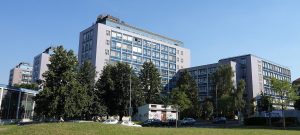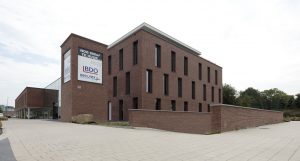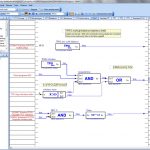MODERN BUILDING CONTROL AND ACTIVE ENERGY MANAGEMENT
We develop software for monitoring, control and building operation. Our main goal is to make the best of our deep knowledge of monitored and controlled technologies and create software that technicians value as a good everyday tool.
Cloud Solutions
Control center as a service
Mervis is a service for complex supervision of all operated technologies. This cloud service provides unified centralized data processing and their easy availability for local operating personnel, central supervision, and, if needed, management access.
It can totally replace local control center and, moreover, adds functions for advanced data evaluation, reports, and effortless access from mobile devices for variety of employees. Thanks to being entirely open, Mervis can be freely connected to additional systems, which need to further work with the operational data.
Mervis responds to present-day requirements on functional and flexible systems and comprises all important components of regular SCADA systems. With the help of modern cloud technology, a constant updating of the system with immediately available new functions is ensured.
Advantages:
- easy access from any place
- user-friendly interface
- secured internet connection
- no service costs for HW and SW
- speed and reliability of operation
- automatic data back-up
Modern building control and active energy management
The share of energy and media costs will increase even more in the future and their proper control is high on agenda of all well-managed companies. To react to this trend, our company created the unique Mervis system for its customers. The system is designed particularly for:
- control of technical equipment in buildings
- monitoring, evaluation, and management of energy and media consumption
- monitoring and evaluation of failure states and emergencies
Technical solutions of Mervis system
The essential part of the whole system is SCADA (Supervisory Control And Data Acquisition). SCADA ensures basic functions of the system needed by technicians-controllers in their work to monitor and to manage the controlled technology. For every connected building or area, a data file is defined which specifies the means for data display and communication with terminal equipment. The display has three basic modes:
- as a list of data points
- as graphic technological diagrams
- as historical charts and overviews
Values from the single data points are periodically stored in the database of historical data. In this database, the data are saved in a special form which enables storing and managing great amount of data (in the order of billions and more records) and fast search and display of the required data at the same time.
Mervis NOTIFICATOR is a special module which serves to control the processing of information about nonstandard situations, failures, and emergencies. The system is able to communicate via:
- sending SMS
- sending informative e-mails
- sending messages to user’s help desk (e.g. Alstanet AFM system)
Within the system, the workflow can be set, i.e. when, to whom, and how messages will be sent. The system stores all alarms in a historical overview and allows their further evaluation and processing.
Energy Dashboard (ED) is a specialized module designed for monitoring and evaluation of energy and media consumption. ED compares the remotely-read real energy consumption with a mathematical model used both as a comparison base and consumption forecast for several next days. It can be utilized for all applications with online collection of data on consumption of heat or similar energies depending on climatic conditions or other influences (e.g. production in manufacturing companies).
To optimize the control in specific buildings, online data from the weather forecast can be used. The data from this module are utilized directly by the regulating system. The achieved savings account for as much as 7 %.
It enables the Mervis system to generate special user reports as combinations of predefined xls files created by the client and historical database data automatically added to the xls files.
Thanks to an open interface, the SCADA system facilitates the integration of additional plugins (supplementary modules) delivered both by our company and third parties. One of the plugins is a predictive regulation for control of heating and cooling in buildings (MPC – Model Predictive Control). The predictive regulation uses a thermodynamic model of a building to optimize the control and thereby to achieve energy saving of more than 10 %.
Desktop Solutions
RcWare SoftPLC – general, multipurpose control system that speaks over 30 different protocols and can run on proprietary controllers as well as commodity Windows or Linux computers.
RcWare DB – highly optimized, specialized database for measurement trends. RcWare DB can work as the optimization and data compression layer on top of SQL databases (MS SQL, Postgres, MySQL), MongoDB or use custom storage solution.
RcWare Vision – traditional SCADA with number of unique features.
Automation
Our building automation solutions are based mainly on Domat building automation hardware and RcWare software tools.
RcWare
The main advantage of RcWare system is the ability of easy integration of third-party software and hardware. This allows low-cost modernization of building automation.
Research
Our company actively participates in research projects focused on energy efficient building control and advanced monitoring. Our company cooperates with several research institutions and universities: ETH Zurich, KU Lueven, CTU Prague, NTIS Pilsen.
In cooperating with CTU, we had developed and successfully applied a unique predictive controller for buildings. This controller is based on online mathematical optimization. It uses weather forecast together with a mathematical model of a building in order to find an energy optimal strategy for building control. This controller is in full scale operation on a CTU building (70 000 m2) since 2008. In 2012, the controller was applied to the pilot building of the Geotabs project. The controller was also used for energy saving analysis in the OptiPremir project.
Research projects
Integration of building systems, research and application of inteligent algorithms with influence on energy consumption of buildings and living houses – 2A-1TP 1/084
 The project (supported by the Ministry of Industry and Trade of the Czech Republic, 2006-2011) was focused
The project (supported by the Ministry of Industry and Trade of the Czech Republic, 2006-2011) was focused
on advanced building control and fault
detection. We developed and successfully applied a predictive controller for CTU building in Prague (70 000 m2). Thanks to the predictive controller, the energy consumption was reduced by 16-27%. This was one of the first full scale applications of predictive control on a real building worldwide.
Optimization of Building Control for the Icade Premier House 1, Munich
 The objectives of the OptiPremier project were (i) the modeling of the newly built „Icade Premier House 1“ buildingin Munich, and (ii) the study and optimization of the indoor temperature control in the office part of the building. The control strategies considered were Rule-Based Control, as implemented in the real building, and so-called Model Predictive Control. The focus was on energy efficiency and thermal comfort in the office rooms. An interdisciplinary team from academia and industry executed the project.
The objectives of the OptiPremier project were (i) the modeling of the newly built „Icade Premier House 1“ buildingin Munich, and (ii) the study and optimization of the indoor temperature control in the office part of the building. The control strategies considered were Rule-Based Control, as implemented in the real building, and so-called Model Predictive Control. The focus was on energy efficiency and thermal comfort in the office rooms. An interdisciplinary team from academia and industry executed the project.
GEOTABS
 The overall aim of the GEOTABS project is to improve system design and control of GEO-HP-TABS in office buildings by using monitoring, comfort survey and simulation data. Hereby, improved design is characterized by increased energy performance as well as increased convenience for future commissioning, while comfort is guaranteed. Monitoring data and simulation data constitute a huge source of information, which is not yet fully exploited to improve system design and control. Moreover, very little is known about users’ comfort experience in TABS buildings. Therefore, a generic international comfort survey tool will be developed and applied to TABS buildings. These data form, together with a current practice review, the ideal foundation in the development of scientifically sound guidelines for improved design and control.
The overall aim of the GEOTABS project is to improve system design and control of GEO-HP-TABS in office buildings by using monitoring, comfort survey and simulation data. Hereby, improved design is characterized by increased energy performance as well as increased convenience for future commissioning, while comfort is guaranteed. Monitoring data and simulation data constitute a huge source of information, which is not yet fully exploited to improve system design and control. Moreover, very little is known about users’ comfort experience in TABS buildings. Therefore, a generic international comfort survey tool will be developed and applied to TABS buildings. These data form, together with a current practice review, the ideal foundation in the development of scientifically sound guidelines for improved design and control.
Knowledge-based Control of the Nystatin Antibiotics Production
The main objective of the project is the increase of the nystatin antibiotics production achieved by decreasing the variability of outcomes of the respective batches of the fermentation phase of the production. The means to achieve the objective is the design of knowledge-based control of fermentation processes as a supervisory level to the classical, current control system. Consecutively, after the process analysis, its mathematical and physiological models will be created, and based on these, the specific knowledge-based control strategy will be designed, which will bring savings of energy and input feeds, and will increase the yield of the fermentation process. The designed solution will be applied on the production of the nystatin antibiotics, while being easily transferable onto production of other antibiotics produced by the Streptomyces genus.
Opticontrol
The project focuses on the application Integrated Room Automation (IRA) in office buildings. IRA deals with the automated control of blinds, electric lighting, heating, cooling, and ventilation of individual building zones. OptiControl combines the newest developments from the fields of building technologies, numerical weather forecasting and control engineering. The project develops and tests novel, predictive control approaches plus corresponding software modules to be incorporated in commercial building automation systems.
Want to know more? Download product leaflet here or send us an email.



